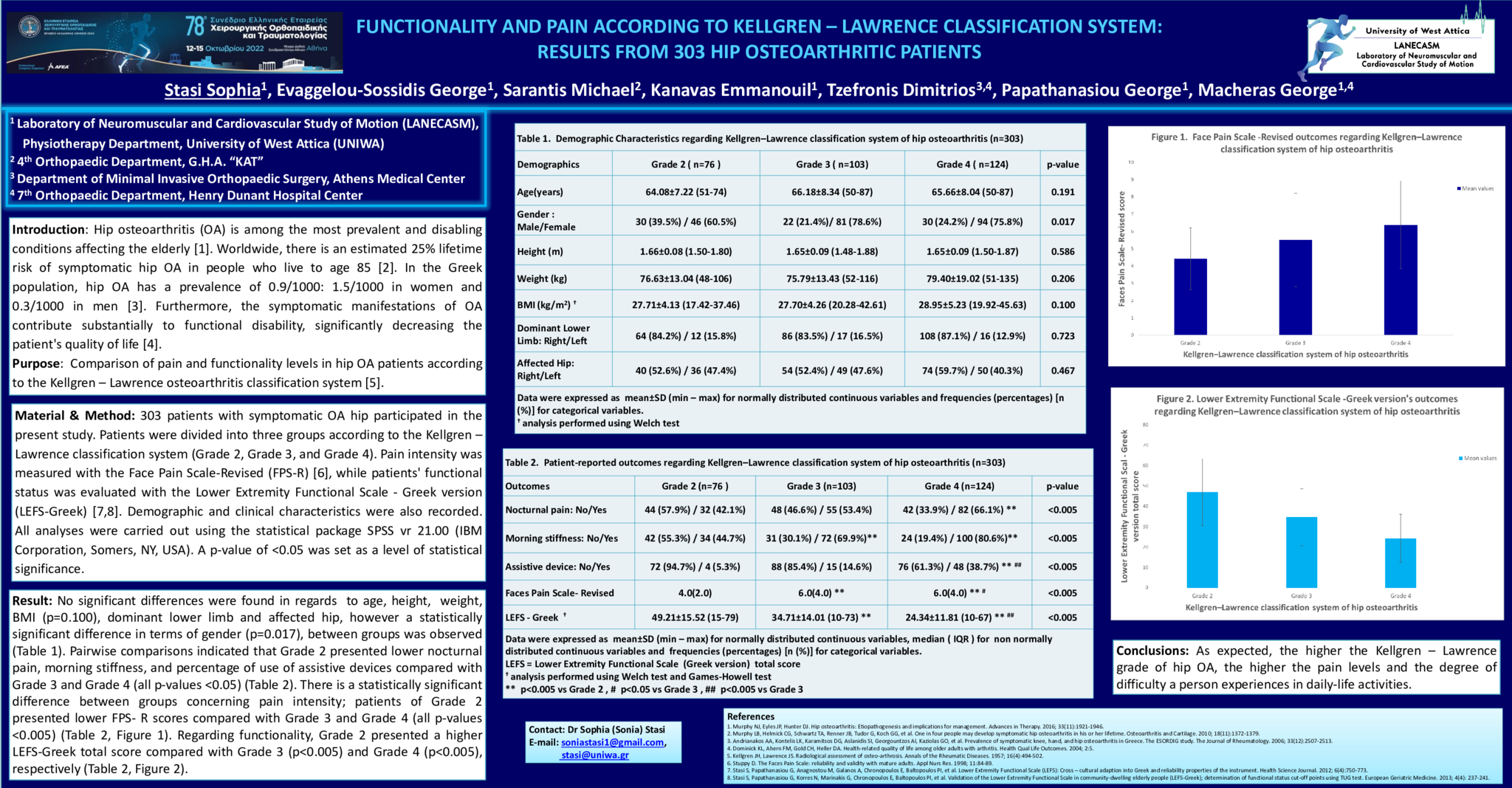Introduction: Hip osteoarthritis (OA) is among the most prevalent and disabling conditions affecting the elderly [1]. Worldwide, there is an estimated 25% lifetime risk of symptomatic hip OA in people who live to age 85 [2]. In the Greek population, hip OA has a prevalence of 0.9/1000: 1.5/1000 in women and 0.3/1000 in men [3]. Furthermore, the symptomatic manifestations of OA contribute substantially to functional disability, significantly decreasing the patient's quality of life [4].
Purpose: Comparison of pain and functionality levels in hip OA patients according to the Kellgren – Lawrence osteoarthritis classification system [5].
Material & Method: 303 patients with symptomatic OA hip participated in the present study. Patients were divided into three groups according to the Kellgren – Lawrence classification system (Grade 2, Grade 3, and Grade 4). Pain intensity was measured with the Face Pain Scale-Revised (FPS-R) [6], while patients' functional status was evaluated with the Lower Extremity Functional Scale - Greek version (LEFS-Greek) [7,8]. Demographic and clinical characteristics were also recorded. All analyses were carried out using the statistical package SPSS vr 21.00 (IBM Corporation, Somers, NY, USA). A p-value of <0.05 was set as a level of statistical significance.
Result: Pairwise comparisons indicated that Grade 2 presented lower nocturnal pain, morning stiffness, and percent use of assistive devices compared with Grade 3 and Grade 4 (all p-values <0.05). There is a statistically significant difference between groups concerning pain intensity; patients of Grade 2 presented lower FPS- R scores compared with Grade 3 and Grade 4 (all p-values <0.005). Regarding functionality, Grade 2 presented a higher LEFS-Greek total score compared with Grade 3 (p<0.005) and Grade 4 (p<0.005), respectively.
Conclusions: As expected, the higher the Kellgren – Lawrence grade of hip OA, the higher the pain levels and the degree of difficulty a person experiences in daily-life activities.
References
1. Murphy NJ, Eyles JP, Hunter DJ. Hip osteoarthritis: Etiopathogenesis and implications for management. Advances in Therapy. 2016; 33(11):1921-1946.
2. Murphy LB, Helmick CG, Schwartz TA, Renner JB, Tudor G, Koch GG, et al. One in four people may develop symptomatic hip osteoarthritis in his or her lifetime. Osteoarthritis and Cartilage. 2010; 18(11):1372-1379.
3. Andrianakos AA, Kontelis LK, Karamitsos DG, Aslanidis SI, Georgountzos AI, Kaziolas GO, et al. Prevalence of symptomatic knee, hand, and hip osteoarthritis in Greece. The ESORDIG study. The Journal of Rheumatology. 2006; 33(12):2507-2513.
4. Dominick KL, Ahern FM, Gold CH, Heller DA. Health-related quality of life among older adults with arthritis. Health Qual Life Outcomes. 2004; 2:5.
5. Kellgren JH, Lawrence JS. Radiological assessment of osteo-arthrosis. Annals of the Rheumatic Diseases. 1957; 16(4):494-502.
6. Stuppy D. The Faces Pain Scale: reliability and validity with mature adults. Appl Nurs Res. 1998; 11:84-89.
7. Stasi S, Papathanasiou G, Anagnostou M, Galanos A, Chronopoulos E, Baltopoulos PI, et al. Lower Extremity Functional Scale (LEFS): Cross – cultural adaption into Greek and reliability properties of the instrument. Health Science Journal. 2012; 6(4):750-773.
8. Stasi S, Papathanasiou G, Korres N, Marinakis G, Chronopoulos E, Baltopoulos PI, et al. Validation of the Lower Extremity Functional Scale in community-dwelling elderly people (LEFS-Greek); determination of functional status cut-off points using TUG test. European Geriatric Medicine. 2013; 4(4): 237-241.
- 3 προβολές






